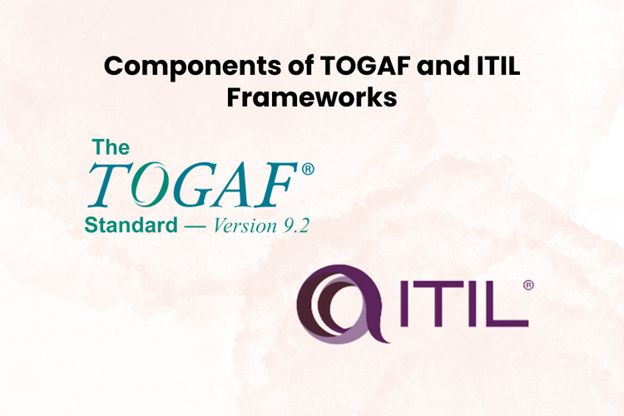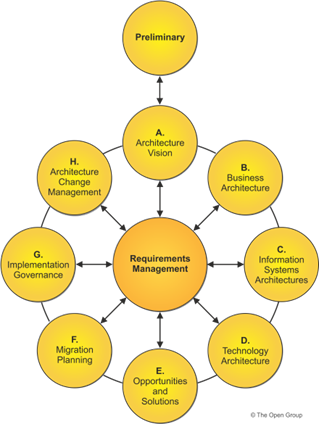
In enterprise architecture and IT service management, two frameworks stand out for their comprehensive approach and widespread adoption: TOGAF (The Open Group Architecture Framework) and ITIL (Information Technology Infrastructure Library).
Both frameworks offer a structured approach to optimising business processes, technology infrastructure, and overall organisational efficiency. As professionals seek to enhance their skills in these areas, TOGAF Training and understanding the differences between TOGAF vs ITIL become pivotal in navigating the complexities of modern IT and business alignment.
Table of Contents
- What is TOGAF?
- What is ITIL?
- Components of TOGAF
- Components of ITIL
- TOGAF vs ITIL
- Conclusion
What is TOGAF?
TOGAF, developed by The Open Group, is a framework designed to assist organisations in defining, planning, implementing, and managing their enterprise architecture. It offers a detailed method for designing, planning, implementing, and governing an enterprise information technology architecture. TOGAF is built around a comprehensive process called the Architecture Development Method (ADM), which guides users through the various aspects of enterprise architecture development.

TOGAF provides a high-level framework for enterprise architecture development and emphasises the importance of aligning IT projects and initiatives with business goals and strategies. This alignment ensures that the technology investments an organisation makes directly contribute to its overall objectives, thus maximising return on investment and driving business growth.
Additionally, TOGAF promotes using a common language and standardised methods among enterprise architecture professionals, facilitating better communication and collaboration within and between organisations.
See Also Unveiling the Expertise of Michael Clements Windward: Navigating Success in the Maritime Realm
What is ITIL?
ITIL (Information Technology Infrastructure Library) is a widely adopted framework for IT service management (ITSM). The UK government created the IT Infrastructure Library (ITIL) in the 1980s to help organisations better match their IT services with their requirements. Improving the efficiency, effectiveness, and quality of IT service delivery and support is the IT Infrastructure Library’s (ITIL) fundamental objective. It emphasises the significance of IT strategy alignment with organisational goals, continuous improvement, and customer happiness.
The ITIL framework consists of a series of publications known as the ITIL Service Lifecycle, which covers the entire lifespan of IT services from conception to retirement. The five phases that make up the Service Lifecycle are strategy, design, transition, operation, and continuous improvement.
Components of TOGAF
Architecture Development Method (ADM)
The ADM is the core of the TOGAF framework, providing a step-by-step approach to developing an enterprise architecture. It outlines eight phases, from the Preliminary Phase (framework and principles) to the Requirements Management phase, ensuring a cyclic and iterative process for continuous improvement.
TOGAF Reference Models
TOGAF includes two reference models: the Technical Reference Model (TRM) and the Integrated Information Infrastructure Reference Model (III-RM). These models provide a set of standardised architectures that serve as templates to guide the development of specific architectures.
Enterprise Continuum
The Enterprise Continuum is a tool for categorising and storing the various components of an architecture within an organisation. It spans from generic Foundation Architectures to more specific Industry Architectures, Organisation-Specific Architectures, and finally, System Architectures.
Architecture Repository
This component serves as a storage space for all organisational architectural assets, including models, patterns, architecture descriptions, and other related documents. It ensures these assets are managed systematically and readily available for project use.
Delving into ITIL
On the other side, ITIL is a set of best practices for IT service management (ITSM) that focuses on aligning IT services with the needs of the business. ITIL aims to provide a scalable and flexible framework to support organisations in managing risk, strengthening customer relations, establishing cost-effective practices, and building a stable IT environment that allows for growth, scale, and change.
Components of ITIL
Service Strategy
This component guides designing, developing, and implementing service management as an organisational capability and a strategic asset. It outlines principles for managing and optimising IT services aligned with business goals.
Service Design
Service Design focuses on designing new IT services and making changes and improvements to existing ones. It covers aspects such as service catalogue management, service level management, risk management, and capacity management.
Service Transition
This phase manages the transition of IT services from development to operations, ensuring that changes to services and Service Management processes are coordinated. It includes change management, release and deployment management, and service testing and validation.
Service Operation
Service Operation focuses on the effective and efficient delivery and support of IT services to ensure value for the customer and the service provider. Key processes include incident management, event management, and request fulfilment.
Continual Service Improvement (CSI)
CSI aims to continually improve the effectiveness and efficiency of IT processes and services, in line with the concept of continual improvement adopted by ITIL. It uses quality management methods to learn from past successes and failures.
TOGAF vs ITIL
While both TOGAF and ITIL offer valuable resources for organisations seeking to optimise their IT and business processes, they serve different, albeit complementary, purposes. TOGAF focuses on the high-level architectural framework of an organisation, offering a strategic approach to the design and implementation of enterprise IT infrastructures. However, ITIL concentrates on service management, providing a detailed set of practices for IT service delivery and support.
Professionals seeking to enhance their expertise in these areas can benefit from TOGAF training, gaining insights into architectural principles, methodologies, and best practices. Understanding the distinct yet complementary nature of TOGAF vs ITIL is essential for IT and business leaders aiming to implement comprehensive, integrated strategies for enterprise development and IT service management.
Conclusion
By understanding and leveraging the components of these frameworks, businesses can achieve a harmonious balance between technology infrastructure and service management, paving the way for innovation and success in the digital age. As we delve deeper into the intricacies of these frameworks, the importance of specialised training and the strategic application of their principles becomes increasingly clear, highlighting the path forward for ambitious organisations and dedicated professionals alike.
